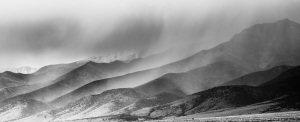Today we are honored to be able to share some information about the indigenous peoples of the Great Basin region. The two videos here are an invaluable glimpse into the sustainable living practices, history, and culture of the indigenous peoples of the Great Basin.
Non-natives have a lot to learn from indigenous peoples about ways of living in balance with each other and the lands. Deep Green Resistance prioritizes solidarity with traditional indigenous peoples. Learn more about our principles and indigenous solidarity guidelines here.
Deep Green Resistance Great Basin is working with people from the Shoshone and Goshute nations to fight the Southern Nevada Water Authority (SNWA) Water Grab. Learn more about that struggle on the Deep Green Resistance Southwest Coalition Website.
Stay posted to our websites for more information about upcoming events related to this work.
Introduction to the Goshute Nation
Paiute, Shoshone, and Washoe Pine Nut Harvesting
From the YouTube Description and Comments:
Old footage of Paiute, Shoshone, and Washoe people gathering, harvesting and preparing pine nuts or pinyon nuts which we Paiutes call “tuba”. Native American natural organic diet.
“It is good the Paiute, Shoshone and Washoe people have conserved this legacy inherited by the Grandfathers,….sadly so much knowledge has been lost due to contact with the whiteman, it is good to know this,…i might add there must be different species of pinyon pines, these were mentioned as soft, thin-shelled nuts, whereas the pine nuts found here on the cnetral plateau have very hard shells, needin’ a hammer to break ’em open. Thumbs up to ya Ahwahneechee and tlaskamati for sharin’!! =) ”
“I recently visited my grandparents who live in North Western Nevada (Fernly). I began to notice i was running into a lot of Native’s and felt really proud to be there! I’m half Apache and many of the Native there around North West Nevada are Paiute & Washoe! So i asked my grandpa if there’s anywhere i can go learn about this tribe and he took me to the famous Pyramid Lake!!! It was beautiful. Snow capped mountains and hill tops, blue water. Time stands still there. Native Nation!!!”
About the Great Basin
The Great Basin covers most of Nevada and parts of Utah, Oregon, Idaho and California. Generally, its east boundary is the Wasatch Mountains of Utah and the western edge is formed by the Sierra Nevada and Cascade Mountains that create a rain shadow over much of the Great Basin, preventing many Pacific storms from reaching the region. Northern and southern boundaries, depending on how they are defined, range from the Snake River Plain in the North to the Mojave Desert in the South.
As part of the Basin and Range Province, mountains and valleys are repeated in succession across the region like great waves cast in time. Valleys are 4,000 to 5,000 feet above sea level and mountain peaks range over 10,000 feet in elevation.
Plant communities define different portions of the Great Basin. Forest communities occur at high elevations and include the oldest living organisms on Earth, the Great Basin bristlecone pines, which can live 4,900 years. Lower in elevation are the pinyon/juniper woodlands.
